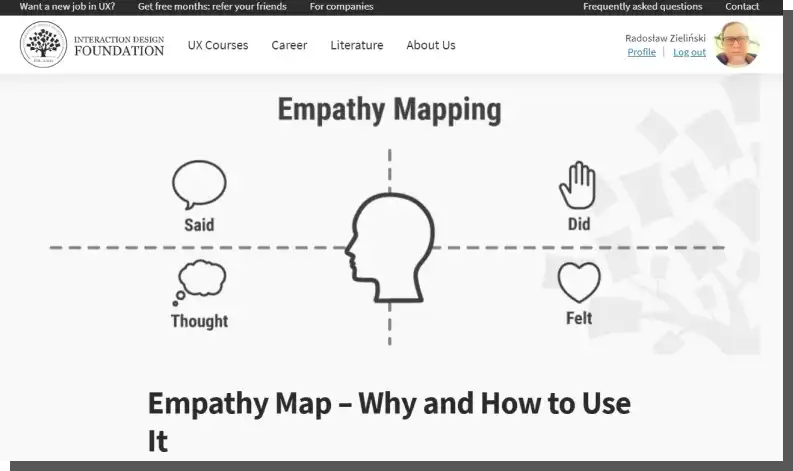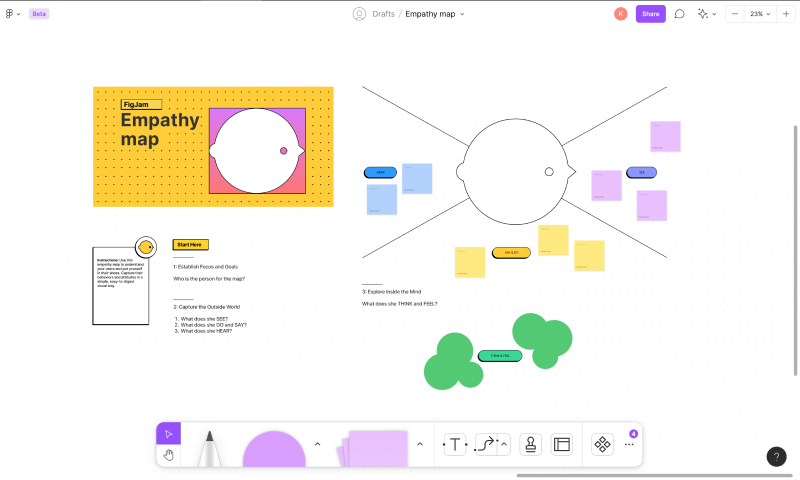Reading the title of this article, you probably wonder what Empathy Maps are. What is this unexpected word combination all about?
The answer to this question should start by reminding us what empathy is and the role of empathizing in marketing, Design Thinking, and digital product design.
What is empathy?
This intriguing-sounding word stands for two things. On the one hand, empathy is a certain ability to feel other people’s emotions and to understand their motivations, needs, reasons for behavior, reactions, and actions.
On the other hand, it is a psychological concept trying to explain and describe this phenomenon through numerous and extensive studies.
In its first sense, empathy can be further divided into two abilities:
- Feeling emotions — emotional empathy
- Understanding the differences in needs, behavior, and ways of thinking — cognitive empathy.
Is the ability to empathize common? Generally, yes, most of us have this ability. But the fact is that its extent and depth could be very different. Fortunately, empathy can be learned, developed, and improved.
Empathy in everyday life
People with more or less developed empathy can go beyond the limits of their own feelings, emotions, and beliefs. They can take another person’s perspective and understand the difference without negation or judgment.
Empathizing abilities are especially desirable in psychotherapists but not just in them. Empathizing ability (innate and learned) is also used in User Research and User Experience Design. Why?
The goal is clear. It is about making a product most relevant to the different expectations of its users and, much more importantly, meeting their needs. Ultimately, it’s always about offering something useful and desirable, something that contributes a particular value and results in a specific, positively evaluated change.
User’s needs and expectations
At first glance, it seems that needs and expectations are synonymous. Not exactly. Expectations result from our desires and dreams and are motivated in a much weaker way than our needs. Expectations can be fleeting and susceptible to change. Needs are much more lasting and indispensable.
Expectations can be diagnosed very easily. It is more complicated with needs (especially those in the upper part of Abraham Maslow’s pyramid of needs).
Empathy is necessary to discover many of them. And the ability to observe, analyze and synthesize.
However, the game is worth the candle as the users and customers are definitely more willing to buy, use and recommend products and services that meet their needs and not only satisfy their expectations. Fulfilled expectations do not evoke such strong emotions as the needs, nor do they create such strong bonds or are the reasons for such deep satisfaction as met needs.
As a tool that allows you to have a more systematic and rational insight into needs, Empathy Map is highly useful for creating digital products. In particular, those that respond to deeper (not always conscious) needs.
Empathizing: Design Thinking, Empathy Map
Empathizing is the first step in the Design Thinking process (we discussed these issues in more detail in this article). In short, just to refresh your memory: Design Thinking is a nonlinear and iterative process applied during prototyping and testing new products. It includes five steps:
- Empathize
- Define
- Ideate
- Prototype
- Test.
It is pretty simple yet complicated. Building a digital product that people need requires understanding their needs and stepping into their shoes. Simply put, what you need is empathy. However, the ability to empathize alone is not enough.
It is also necessary to search for these needs according to the pattern and in a targeted manner. It is necessary to seek information that is useful from the perspective of the design process and the final result in the form of a very good UX.
A digital product cannot be the sum of its creators' needs, preferences, habits, and stereotypical beliefs. It should focus on meeting the user's expectations and needs as much as possible.
As already mentioned, empathizing is innate but can also be learned. Through self-control, self-awareness, mindfulness, and asking the right questions, you can get closer and know and understand the uniqueness of other people's perspectives.
Empathizing is primarily an observational method focused on outlining the observation area (What do the users do?), understanding the behavior (How do they do it?), and formulating hypotheses (Why do they do it?).
Naturally, looking for answers to these questions can employ other research methods (e.g., interviews), but Empathy Map is one of the most popular.
Empathy Map template. What is Customer Empathy Map?
The most significant advantage of the Empathy Map is its simple and communicative form. No expert knowledge is required to understand its goals, assumptions, benefits, and area of application (and it is pretty broad). No experience is needed either.
Due to its usefulness, it is used during meetings with customers. It is also a daily tool for design teams.
For example, Empathy Maps are frequently and successfully used to create Personas.

As a profile method, the Empathy Map template focuses on the following four essential issues (from the perspective of digital product usability):
- Needs
- Experiences
- Thoughts
- Emotions.
Therefore, the Customer Empathy Map provides insight into what the users want, what they are used to, what they think about the existing and proposed solutions (e.g., functionalities), and what emotions they feel in contact with them.
A sample Empathy Map in a standard format, sometimes expanded with additional components (e.g., concerns and needs and information that comes through the senses of sight and hearing), consists of a diagram including four fields.
Information from various sources, from superiors and co-workers to the information appearing in the media, coming from government officials, authorities, and influencers, also have an impact. They are included in some Empathy Map variants as another crucial factor.
It is similar to the information received by sight. Visual stimuli experienced at work and in public and private spaces are equally important. They influence emotions and attitudes.
Obstacles and problems that restrict or impede achieving goals and cause frustration and tension should also be taken into account. Broader and more profound understanding and insight are also gained by considering desires and the definition of success, goals, and acceptable and optimal measures allowing the users to achieve them.
In the center of the diagram is an individual user. They also function as a model representative of a given customer segment.
The four fields enable you to describe, define, name, and specify what the user would:
- Say
- Do
- Think
- Feel during the research.
The first two points do not cause significant problems. But the issues concerning thoughts and emotions particularly require the eye for detail and the ability to "read between the lines" and draw conclusions about emotional states based on various sources (e.g., body language).
In the case of Statements, it is important to focus on keywords, often repeated opinions that demonstrate the attitude and statements of the persons evaluating. Observation of behavior should be reflected in the Empathy Map in the form of descriptions of meaningful behavior and attitudes expressed in behavior.
The Thoughts component is essentially the sum of Behavior and Statements and their in-depth analysis and interpretation through which you try to diagnose the following:
- Motivations
- Goals
- Desires
- Beliefs
- Notions
- And, most importantly, needs.
The confirmation of assumptions can be found in the field devoted to Emotions whose verbal and behavioral equivalents are gestures, facial expressions, vocal intensity, and the choice of words.
UX Empathy Map: how to use it?
You start the work on and with the Map filling each canvas field. A best practice is to follow the principle of the golden mean, which helps you to avoid overloading the Map with information.
On the other hand, it protects you against unwanted reductionism, which lowers the usefulness of this tool. In other words, Empathy Map can neither be too short on information nor overflow with detail of secondary importance.

The next step is the synthesis of needs. How are the needs most commonly expressed? In verbal form, using verbs suggesting expectations and needs.
You should pay attention to verb-adverb combinations (e.g., “is supposed to work quickly”).
Statements of this type are the expression of expectations but also needs (e.g., the need for effectiveness, savings, or quick gratification). You can also notice needs in Behavior and the contradictions between declarations, opinions, and evaluations expressed in Statements and Behavior (e.g., the declaration “I’m not thirsty” and reaching for a bottle of water).
Empathy Map, Design Thinking. Summary
The ultimate goal of the Empathy Map is to synthesize the information obtained and conclusions drawn. Formulation of conclusions has a practical purpose: it indicates the direction for the design but is also used to create Personas. The conclusions can also serve to find Insights.
By creating Empathy Map, you can be sure that you employ a simple and very useful method that enables you to go beyond the limits of your own perspective. It is invaluable in creating digital products because it embodies the user’s expectations and needs.
It allows you to understand better what customers think and feel, say and do, and what benefits they expect. Thus, it enables you to expand the business model with the important issues of user emotions.







